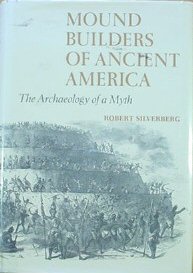Mound Builders of Ancient America: The Archeology of a Myth
- Year
- 1968
- Publisher
- New York Graphic Society
- Country
- USA
- Pages
- 369
- Media
- Hard cover book
- ISBN
- Cover art
- Unknown

Blurb
The mounds of the Mississippi Valley and southeastern United States are major monuments of the prehistory of North America. Nearly every important waterway in the Midwest is rimmed by clusters of mounds, ten thousand of them in the valley of the Ohio alone. Some are of colossal size, like Cahokia Mound in Illinois, a hundred feet high and covering sixteen acres of land; others are mere blisters rising from the earth.
Who built the mounds?
To the first settlers who pushed beyond the Alleghenies, these earthworks were a major mystery. The semi-nomadic Indians appeared to have no knowledge of their origin—nor did these "savages" seem to the nineteenth century white man capable of the organized effort and geometric complexities demonstrated by the mounds. Inexorably, the myth arose of a "vanished race" and a "lost civilization."
By 1800 the "mystery of the mounds" had become a favorite topic of scientific study—and for popular literature, fanciful theorizing, and outright PT Barnum charlatanism. Treatises, serious and otherwise, were written to prove that the Mound Builders were immigrants from Mexico, refugees from Atlantis, wandering Danes or Malays, or descendents of the Ten Lost Tribes of Israel. Mr Silverberg recounts with zest and many quotations from original sources this chapter of American romanticism.
The Mound Builder legend was finally laid to rest by the early work of the Smithsonian Institution, whose excavations and studies of mound sites laid the foundation of accurate knowledge of North American prehistory. This book chronicles the establishment of archaeology as a science in America as well as the lore of the myth. It offers a comprehensive survey of the present state of knowledge of the various Indian groups who produced the mounds: the rich and creative Hopewell and Adena peoples with their far-ranging trading "empire" based in the Ohio Valley and the various cultures of the upper and lower Mississippi who produced the flat-topped Temple Mounds and a remarkable and mysterious assortment of "death cult" objects of art.